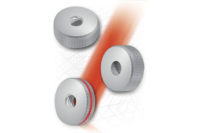In today’s demanding manufacturing environment, it is vital that all of your threaded parts are properly inspected with the correct types of thread gages. Choosing the proper inspection instrument is a critical quality control decision; the wrong device or method could produce inaccurate results and also affect the cost and performance of the parts that are inspected.
For metric ISO threads—the most commonly used type of general-purpose screw thread worldwide—the gage system specified is ISO1502, which is used to ensure the unlimited compatibility of workpiece threads. In modern thread production, there are many various tools and inspection methods, from fixed limit gages to dial or digital types. Regardless of the tools or methods, it is important to make sure that the same results are achieved. In any case of doubt, the gages recommended in the standard ISO1502 will decide the result of the inspection for the metric ISO thread.
Gages should also meet U.S. thread standards such as ASME/ ANSI B1.2 for unified screw threads and ANSI B1.16M for metric screw threads. In some cases, other standards may also apply, such as FED-STD-H28/ System 21, 22, or 23 and other MIL standards, depending on the application and industry in which the gages and gaging systems are utilized. In addition to standards, traceability to the National Institute of Standards and Technology (NIST) may also be desired or required.
If the inspection work in production is done mainly by measuring, it is still absolutely necessary to perform random sample inspection with standardized gages. It is important to note that the reference temperature for the gage and workpiece dimensions should be 68 F (20 C) to ensure inspection accuracy. If inspections are done at other temperatures, expansion coefficients need to be taken into account.
When purchasing precision fixed limit thread gages, it is imperative to select a quality gage. Following are some important general features and benefits to look for in a thread gage:
- Aged gage steel that is extremely stable and true to dimension
- Hardness that is noticeably over the standardized minimum requirements
- Extra high wear resistance
- Availability of standard and special tolerance models
- Special designs that may be required
- Inspection certificates available upon request (issued by an independent or in-house inspection lab)
- Ability to laser mark custom specifications on gages
- Gage handles with double surfaces leaving sufficient space for specific marking requirements
- Incomplete threads that are removed before the beginning of the first full thread for creating a stable thread start
- Plug gages provided with a dirt flute, for safe gaging even under difficult conditions
- Knurled handles for safe handling and improved gripping
- Reduced thread start for easy insertion of the no-go gage body
- Recessed minor thread diameter of the no-go gages for safe function
- Gages manufactured by companies that are ISO 9001-certified
Gages for internal threads
The go thread plug gage and the no-go thread plug gage are used for the gaging of internal threads. Go and no-go plug gages are mounted on a common handle for thread diameters up to 40 millimeters (mm) and are designated as go/no-go thread plug gages. For exceptional cases, handles for go/no-go thread plug gages up to a thread diameter of 62 mm are standardized in DIN 2240-2. A (smooth) go and no-go plug gage is recommended for gaging the internal thread minor diameter.
The go thread plug gage checks the so-called “virtual size” of the internal thread and the proper screw-in fit. In doing so, it checks the smallest size of the internal thread pitch diameter D2, including certain form deviations in the thread, such as pitch and thread profile angle deviations. It also checks the smallest size of the major diameter. The minor diameter D1 of the internal thread is not checked.
The go thread plug gage must be able to be screwed by hand into the full length of the workpiece thread without using force. (Note: a gage should be screwed firmly but must never be forced into the part being checked.) The go thread plug gage is subject to wear and should be checked at regular intervals, so it is recommended to use go thread plug gages in a hard chrome-plated or TiN-coated version. The acceptable wear of the go thread plug gage is determined by measurement based on the three-wire method.
The go thread plug gage has a full thread profile along its thread length. It should be noted that the thread length is not less than 80% of the screw-in length of the workpiece thread. According to DIN ISO 1502, no so-called “acceptance” go plug gages are standardized. It is a good practice to always use new plug gages for production and keep those that are close to their wear limit in the inspection room.
The no-go thread plug gage checks whether the actual pitch diameter of the workpiece internal thread exceeds the largest specified size. The no-go thread plug gage should not be able to be screwed into the workpiece thread by hand for more than two revolutions (from both sides) without any force.
The go/no-go thread plug gage is a combination of a go thread plug gage and a no-go thread plug gage on one handle. The dimensions of the go/no-go thread plug gages are specified up to a nominal dimension diameter of 40 mm in DIN 2280. It provides the functionality of both the go and no-go thread plug gages.
The internal thread minor diameter D1 is checked with plain cylindrical go and no-go plug gages or a go/no-go plug gage. Because the minor diameter can change during thread tapping, an inspection is required after the thread has been completed. The internal thread minor diameter should be checked before gaging the internal thread pitch diameter. The smooth go plug gage should be able to be guided by hand through the workpiece thread without the use of force. It must not be possible to insert the smooth no-go plug gage into the workpiece thread from both sides deeper than one pitch (1 x P) from the start of the thread.
Analog and digital thread depth plug gages
Go/no-go thread depth analog and digital plug gages permit the gaging of threads and the measuring of thread depth in a single operation. They are typically used for components with identical thread sizes and different thread depths, and for setting the thread depth in all kinds of internal thread production. By pushing the spring-loaded scaled sleeve into the handle, the fully cut thread depth can be read quickly and precisely.
In the industry, opinions vary concerning the full gage length of a go thread plug gage. One of the advantages of using a thread depth plug gage is that it can be easily adjusted to a number of variants without the use of auxiliary tools. For example, a gage with a scaled sleeve can either be set to the face of the go gage body, or to the beginning of the incomplete thread. Smaller contours on the workpiece surface, like countersunk edges or elevations, and small dimensional variations of different go gage bodies can also be compensated for with an easy adjustment.
The analog plug gage should meet all the requirements and gaging criteria as specified in ISO 1502 for standard go/no-go thread plug gages. Some helpful features to look for when selecting a plug gage include:
- Simple and safe handling, which can help significantly reduce inspection work
- A full range of sizes available
- Measurable thread depth of up to 4 x D
- Easy to adjust
- Universally applicable due to exchangeable gage bodies
- Availability of TiN-coated gage bodies for extra wear resistance
- Measuring accuracy of 0.5 mm (0.020 inch)
- Available with locking screw
In some gage designs, when a go gage body on a thread depth analog plug gage has reached its wear limits, it can simply be extracted with a pulling sleeve and a common hexagon nut and replaced with a new gage body.
A digital plug gage should also meet all the requirements and gaging criteria as specified in ISO 1502 for standard go/no-go thread plug gages. Some important features to look for when purchasing a digital gage include:
- Simple and safe handling that can reduce inspection work by 50%
- A full range of sizes
- Measurable thread depth of up to 2.5 x D
- Easy to adjust
- Universally applicable due to exchangeable gage bodies
- Availablilty of TiN-coated gage bodies for extra wear resistance
- Tolerance of 0.001 mm (0.0001 inch)
- Large, easy-to-read LCD display
- Available with locking screw
In order to determine the exact thread depth, screw the digital plug gage down to the very bottom of the thread. The full finished thread depth can then be read by resetting the display to zero and unscrewing the plug gage from the workpiece. Using this process, gaging becomes possible even in obscured locations.
Gaging of other threads
Gaging other threads such as sealing threads, tapered threads, and threads for tight fit require thread gages that often deviate considerably from the normal gage design. They are usually adjusted to the special design and function of these threads.
When inspecting threads, it’s important to remember not only to use the proper gage, but to use it correctly. Good thread performance hinges on proper thread inspection and gage calibration, as well as meeting current thread inspection standards.
|
TECH TIPS
|





